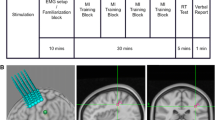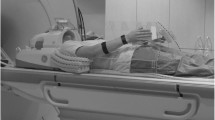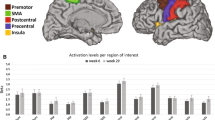Abstract
The aim of this study was to investigate the involvement of the parietal cortex during motor imagery (MI). In experiment one, participants imagined a sequence of upper limb movements during FMRI scanning. Statistical parametric mapping revealed a network of activation consistent with previous MI research, including activation in right and left inferior and superior parietal cortex. In experiment two, participants imagined a sequence of upper limb movements while real or sham single-pulse TMS was delivered over the scalp area corresponding to each individual’s left or right superior parietal cortex. At the end of each trial, participants moved their upper limbs to the position that would result from executing the sequence of movements. TMS degraded accuracy of MI compared to sham stimulation, and both accuracy and confidence decreased with real and sham stimulation later in the MI sequence. The effects of TMS were similar when delivered to either hemisphere. The results of this study provide evidence of the crucial role of SPL in MI, and may have implications for rehabilitation from brain injury.




Similar content being viewed by others
References
Andersson JL, Hutton C, Ashburner J, Turner R, Friston K (2001) Modeling geometric deformations in EPI time series. Neuroimage 13:903–919
Aron AR (2007) The neural basis of inhibition in cognitive control. Neuroscientist 13:214–228
Aron AR, Robbins TW, Poldrack RA (2004) Inhibition and the right inferior frontal cortex. Trends Cogn Sci 8:170–177
Bestmann S, Thilo KV, Sauner D, Siebner HR, Rothwell JC (2002) Parietal magnetic stimulation delays visuomotor mental rotation at increased processing demands. Neuroimage 17:1512–1520
Cornette L, Dupont P, Salmon E, Orban GA (2001) The neural substrate of orientation working memory. J Cogn Neurosci 13:813–828
Coxon JP, Stinear CM, Byblow WD (2009) Stop and go: the neural basis of selective movement prevention. J Cogn Neurosci 21:1193–1228
Danckert J, Ferber S, Doherty T, Steinmetz H, Nicolle D, Goodale MA (2002) Selective, non-lateralized impairment of motor imagery following right parietal damage. Neurocase 8:194–204
de Vries PM, de Jong BM, Bohning DE, Walker JA, George MS, Leenders KL (2009) Changes in cerebral activations during movement execution and imagery after parietal cortex TMS interleaved with 3T MRI. Brain Res 1285:58–68
Decety J, Grezes J (1999) Neural mechanisms subserving the perception of human actions. Trends Cogn Sci 3:172–178
Eickhoff SB, Stephan KE, Mohlberg H, Grefkes C, Fink GR, Amunts K et al (2005) A new SPM toolbox for combining probabilistic cytoarchitectonic maps and functional imaging data. Neuroimage 25(4):1325–1335
Fiehler K, Burke M, Engel A, Bien S, Rosler F (2007) Kinesthetic working memory and action control within the dorsal stream. Cereb Cortex 18:243–253
Ganis G, Keenan JP, Kosslyn SM, Pascual-Leone A (2000) Transcranial magnetic stimulation of primary motor cortex affects mental rotation. Cereb Cortex 10:175–180
Gerardin E, Sirigu A, Lehericy S, Poline JB, Gaymard B, Marsault C, Agid Y, Le Bihan D (2000) Partially overlapping neural networks for real and imagined hand movements. Cereb Cortex 10:1093–1104
Hanakawa T, Immisch I, Toma K, Dimyan MA, Van Gelderen P, Hallett M (2003) Functional properties of brain areas associated with motor execution and imagery. J Neurophysiol 89:989–1002
Jahanshahi M, Rothwell J (2000) Transcranial magnetic stimulation studies of cognition: an emerging field. Exp Brain Res 131:1–9
Jeannerod M, Decety J (1995) Mental motor imagery: a window into the representational stages of action. Curr Opin Neurobiol 5:727–732
Kuhtz-Buschbeck JP, Mahnkopf C, Holzknecht C, Siebner H, Ulmer S, Jansen O (2003) Effector-independent representations of simple and complex imagined finger movements: a combined fMRI and TMS study. Eur J Neurosci 18:3375–3387
Oldfield RC (1971) The assessment and analysis of handedness: the Edinburgh inventory. Neuropsychologia 9:97–113
Pascual-Leone A, Bartres-Faz D, Keenan JP (1999) Transcranial magnetic stimulation: studying the brain–behaviour relationship by induction of ‘virtual lesions’. Philos Trans R Soc Lond B Biol Sci 354:1229–1238
Pascual-Leone A, Walsh V, Rothwell J (2000) Transcranial magnetic stimulation in cognitive neuroscience—virtual lesion, chronometry, and functional connectivity. Curr Opin Neurobiol 10:232–237
Rom D (1990) A sequentially rejective test procedure based on a modified Bonferroni inequality. Biometrika 77:663–665
Rossini PM, Rossi S (2007) Transcranial magnetic stimulation: diagnostic, therapeutic, and research potential. Neurology 68:484–488
Sack AT (2006) Transcranial magnetic stimulation, causal structure–function mapping and networks of functional relevance. Curr Opin Neurobiol 16:593–599
Sack AT, Sperling JM, Prvulovic D, Formisano E, Goebel R, Di Salle F, Dierks T, Linden DE (2002) Tracking the mind’s image in the brain II: transcranial magnetic stimulation reveals parietal asymmetry in visuospatial imagery. Neuron 35:195–204
Sirigu A, Duhamel JR, Cohen L, Pillon B, Dubois B, Agid Y (1996) The mental representation of hand movements after parietal cortex damage. Science 273:1564–1568
Stephan KM, Fink GR, Passingham RE, Silbersweig D, Ceballos-Baumann AO, Frith CD, Frackowiak RS (1995) Functional anatomy of the mental representation of upper extremity movements in healthy subjects. J Neurophysiol 73:373–386
Szameitat AJ, Shen S, Sterr A (2007a) Effector-dependent activity in the left dorsal premotor cortex in motor imagery. Eur J Neurosci 26:3303–3308
Szameitat AJ, Shen S, Sterr A (2007b) Motor imagery of complex everyday movements. An fMRI study. Neuroimage 34:702–713
Talairach J, Tournoux P (1988) Co-planar stereotaxic atlas of the human brain: 3-dimensional proportional system—an approach to cerebral imaging. Thieme Medical Publishers, New York
Wager TD, Smith EE (2003) Neuroimaging studies of working memory: a meta-analysis. Cogn Affect Behav Neurosci 3:255–274
Walsh V, Cowey A (2000) Transcranial magnetic stimulation and cognitive neuroscience. Nat Rev Neurosci 1:73–79
Acknowledgments
We thank James Coxon, Lynley Bradnam and Suzanne Ackerley for their assistance with data collection, Fung Yang for technical support and the staff at The University of Auckland Centre for Advanced MRI.
Author information
Authors and Affiliations
Corresponding author
Rights and permissions
About this article
Cite this article
Fleming, M.K., Stinear, C.M. & Byblow, W.D. Bilateral parietal cortex function during motor imagery. Exp Brain Res 201, 499–508 (2010). https://doi.org/10.1007/s00221-009-2062-4
Received:
Accepted:
Published:
Issue Date:
DOI: https://doi.org/10.1007/s00221-009-2062-4




